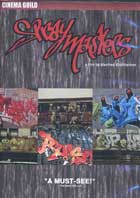
SprayMasters 2006
Distributed by Cinema Guild, 115 West 30th Street, Suite 800, New York, NY 10001; 212-685-6242
Produced by Manfred Kirchheimer
Directed by Manfred Kirchheimer
DVD, color, 85 min.
Jr. High - Adult
Art, Art History, Design, American Studies, Popular Culture, New York City, Urban Studies, Advertising, Graffiti Culture
Date Entered: 06/10/2010
Reviewed by Winifred Fordham Metz, University of North Carolina at Chapel HillManfred Kirchheimer first introduced audiences to the New York City subway graffiti art movement with his 1980 documentary film, Stations of the Elevated. Twenty-six years later, Kirchheimer revisits the subject, using plenty of the remarkable subway train footage he originally filmed in 1977 but this time bringing four of the renowned graffiti writers along for the ride.
Kirchheimer turns the camera from art to artist; asking Zephyr, Lee Quinones, Lady Pink and Futura 2000 to recount how, armed with cans of stolen spray paint and a passion to see their masterpieces go “all city,” they each came to sneak into rail yards and tunnels as NYC youth in the early 1970s and ‘80s. Lee, now an internationally recognized artist, started racking paint and tagging trains when he was a mere lad of 14. Credited as one of the more prolific graffiti writers of his time, Lee was also one of the first to go international with a gallery show in Rome in 1980. He remembers being influenced by Pam Grier in a series of Blaxploitation films and likens his early graffiti experiences to being a Ninja. We learn that Pink, a successful muralist and graffiti ambassador, began tagging because she wanted to memorialize her high school boyfriend who had recently been deported. Journalist Zephyr was also in his teens when he began painting graffiti and recounts being influenced by Abby Hoffman early on and while having political intent behind his initial efforts, wryly admits “you know, I liked to paint my name” on stuff. Futura talks about some of his earliest graffiti exploits with friend Ali and his rise, fall and eventual reprise in the medium with backing from fashion mogul Agnes B.
It is these interesting personalities behind the paint and their candid reflections that elevate a traditional art doc mix of talking-head style interviews interspersed with archival footage to a revealing contextual narrative. Their collective voices effectively work together to provide a rich journey through the NYC graffiti movement itself - charting its initial explosion, the shift from rail to gallery (with brief stops on social and political relevance), expansion abroad, and partnership with hip-hop that led it to coast comfortably into advertising and fashion.
Look for shots of Lee’s “Heaven is Life-Earth is Hell” masterpiece and note graffiti vernacular subtitles on the screen during several sections of the interviews (terms like: burners, lay-up, motion tagging, throwing-up, bombing, all city, masterpiece, racking).
This film is recommended for people interested in art, art history, popular culture, graffiti culture and design. Film may easily be used in middle school classrooms and higher to motivate discussions on these and other similar topics.